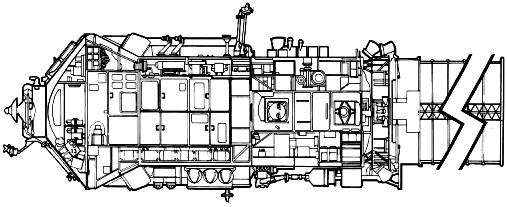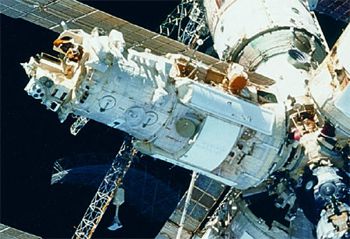
Home - Search - Browse - Alphabetic Index: 0- 1- 2- 3- 4- 5- 6- 7- 8- 9
A- B- C- D- E- F- G- H- I- J- K- L- M- N- O- P- Q- R- S- T- U- V- W- X- Y- Z
Priroda

Priroda Cutaway
Priroda was the last of the Mir modules.
AKA: 11F77I;TsM-I 77KSI. Status: Operational 1996. First Launch: 1996-04-23. Last Launch: 1996-04-23. Number: 1 . Gross mass: 19,000 kg (41,000 lb). Height: 13.00 m (42.00 ft).
The Soviet Union collapsed before it could be launched, and it was put in storage. In 1993 NASA agreed to provide funds to complete the Spektr and Priroda modules for Mir using US funds, providing 600 to 700 kg of US experiments would be installed. It finally docked with Mir in April 1996.
Priroda was to be the last Mir module launched. Its origins can be traced back to the 37KP remote sensing module originally programmed for Mir, which would have combined civilian and military surveillance of the earth. In 1985 the module took on an international aspect when experiments scheduled for launch aboard smaller satellites within the Interkosmos program were moved to Priroda. At that time launch was schedule for 1990; but by 1990 this had been pushed back to 1992. With the break-up of the Communist state, non-Russian experiments from other parts of the former Soviet Union were deleted (Ainur, Marina, Korund 1MP, Volna-2), and the German MOMS-2P multispectral scanner was added. Then the funding dried up entirely and in 1992 the module was put into storage.
In July 1993, as part of joint US-Russian activities leading up to the International Space Station, NASA agreed to provide funds to complete the Spektr and Priroda modules for Mir using US funds, providing 600 to 700 kg of US experiments would be installed. Due to weight growth a forward retractable solar panel was deleted from the module (it was delivered later by Progress and installed by cosmonauts in an EVA). To power Priroda during its period of free-flight before docking with Mir, 160 expendable Al-Li batteries were installed, but the planned one month of autonomous flight before docking with Mir was eliminated. Priroda was taken out of storage in early 1994, delivered to the final test hall in Korolev in November 1995, and arrived at Baikonur in January 1996. The module originally docked with the station on April 26, 1996. It was transferred to its final location at the Mir transfer compartment's port side radial docking port on April 27.
Originally the modules attached to the Mir base block were to be of the NPO Energia 37KS design. Design and fabrication reached an advanced phase when it was decided that the separate tug concept resulted in too low a net scientific payload (3 metric tons). Integrating the tug with the module was expected to increase this to 5 metric tons and provide some reserve engine capability at Mir and additional pressurized volume. Accordingly the 37KS modules for Mir were cancelled in 1983. Competitive designs for integrated space station modules were submitted by KB Salyut and NPO Energia. The KB Salyut 77K modules were derived from the cancelled TKS manned ferry. The competing proposal from NPO Energia combined the 37KS module with the engine unit of Mir. In June 1984 the KB Salyut design was selected. The revised Mir program plan was to assemble the station over a three year period, and operate it for ten years (versus the original one year/five years).
Description
Priroda ("Nature"), the last of the Mir modules, was designed for Earth remote sensing. The mission's internationally provided experiments supported a six-point research program for (1) determination of atmosphere-ocean system characteristics, (2) measurements of land local characteristics, (3) measurements of optical characteristics of the atmosphere, (4) investigation of the sea surface roughness state, (5) comparison of radiation and reflection characteristics of the sea surface in the microwave range, and (6) measurements of the concentrations of trace gases in the atmosphere. Specific remote sensing objectives included measurements of ocean surface temperatures to within 0.5 deg K, measurements of surface wind velocities to within 1 m/s and +/-20 deg. , atmospheric temperature profile to within 3K, sea wave height measurements to within 20 cm, and cloud temperature measurements to within 1K. The vehicle also supported materials science, space technology, biotechnology and life sciences studies. The module had a total pressurized volume of 66 cubic meters.
Priroda did not carry any solar arrays and relied on its internal battery system when not attached to the station. Propulsion consisted of two 3.9 kN main engines and 400N attitude control thrusters used during the initial docking process.
Scientific equipment delivered with Priroda included:
- Ainur electrophoresis unit.
- Korund 1MP semiconductor unit.
- Ikar N nadir microwave radiometers - 0.3, 0.8, 1.35, 2.25 6.0 micrometer wavelengths, resolution up to 60km and 0.15 deg. K.
- Ikar D scanning microwave radiometer system - scanned 40 deg off track with a 400 km swath. 4.0, 0.3, 0.8, 1.35 micrometer wavelengths, resolution up to 5 km and 0.15 deg. K.
- Ikar P panoramic microwave radiometers - 2.25, 6.0 micrometer wavelengths, 750 km swath, resolution up to 75 km and 0.15 deg. K.
- Istok 1 IR spectroradiometer - wavelengths between 4.0-16.0 micrometer, 7 km swath, 0.7 x 2.8 km resolution.
- Ozon M spectrometer - used for ozone/aerosol profiles. 160 channels between 0.257-1.155 micrometer, 1 km altitude resolution.
- Travers Synthetic Aperture Radar - 1.28/3.28 GHz, 50 km swath, 38 deg. look angle, 50 m resolution.
- Alissa lidar - measured cloud height, structure, optical properties. 150 m vertical resolution, 1 km horizontal resolution.
- MOS-Obzor spectrometer - measured aerosol profile and ocean reflectance. 17 channels between 0.750-1.01 micrometer, 80 km swath, 700 m resolution.
- MSU-E2 high resolution optical scanner - 10 m resolution, 3 channels between 0.5 and 0.9 micrometer, nadir viewing, 2 x 24.5 km swaths.
- DOPI interferometer - studies gases and aerosols. 2.4-20 micrometer.
- Greben ocean altimeter - 10 cm resolution, 13.76 GHz, 2.5 km swath, nadir viewing.
- Centaur 400 MHz receiver - used to gather ocean buoy data.
- MOMS 02P Earth imager - 4 channels between 0.440-0.810 micrometer. Multi spectral, stereo or high resolution data, 6 km resolution. German instrument, initially flown aboard Spacelab D2 on Shuttle.
More at: Priroda.
Family: Soviet Space Stations, Space station, Space station orbit. Country: Russia. Engines: KRD-442. Spacecraft: Mir, Mir complex. Launch Vehicles: Proton, Proton-K. Launch Sites: Baikonur, Baikonur LC81/23. Agency: Chelomei bureau, RAKA. Bibliography: 182, 2, 20, 274, 453, 6, 67, 8, 6793, 12972.
 | Priroda Credit: Manufacturer Image |
1983 November - .
- 37KS Modules for Mir cancelled, replaced by FGB modules. - .
Nation: Russia.
Spacecraft: 37KS,
Kristall,
Kvant,
Kvant-2,
Mir,
Priroda,
Spektr.
Design and fabrication reached an advanced phase when it was decided that the separate tug concept resulted in too low a net scientific payload (3 tonnes). Integrating the tug with the module was expected to increase this to 5 tonnes and provide some reserve engine capability at Mir and additional pressurised volume. Accordingly the 37KS modules for Mir were cancelled. Work on the 37KE experimental module (Kvant) and the 37KB Buran modules continued. The function of the 37KS modules was taken up by modules by KB Salyut derived from the FGB. A competing proposal from NPO Energia for a unified spacecraft that combined the 37KS module with the engine unit of Mir was rejected.
1996 April 23 - . 11:48 GMT - . Launch Site: Baikonur. Launch Complex: Baikonur LC81/23. LV Family: Proton. Launch Vehicle: Proton-K.
- Priroda - . Payload: 77KSI s/n 17401. Mass: 19,000 kg (41,000 lb). Nation: Russia. Agency: RAKA. Program: Mir. Class: Manned. Type: Manned space station. Flight: Soyuz TM-23, STS-76 Mir NASA-1. Spacecraft Bus: Mir. Spacecraft: Priroda. Decay Date: 2001-03-23 . USAF Sat Cat: 23848 . COSPAR: 1996-023A. Apogee: 347 km (215 mi). Perigee: 220 km (130 mi). Inclination: 51.67 deg. Period: 89.89 min. LEO. Remote sensing module for Mir space station Docked with Mir Apr 26. .
Back to top of page
Home - Search - Browse - Alphabetic Index: 0- 1- 2- 3- 4- 5- 6- 7- 8- 9
A- B- C- D- E- F- G- H- I- J- K- L- M- N- O- P- Q- R- S- T- U- V- W- X- Y- Z
© 1997-2019 Mark Wade - Contact
© / Conditions for Use